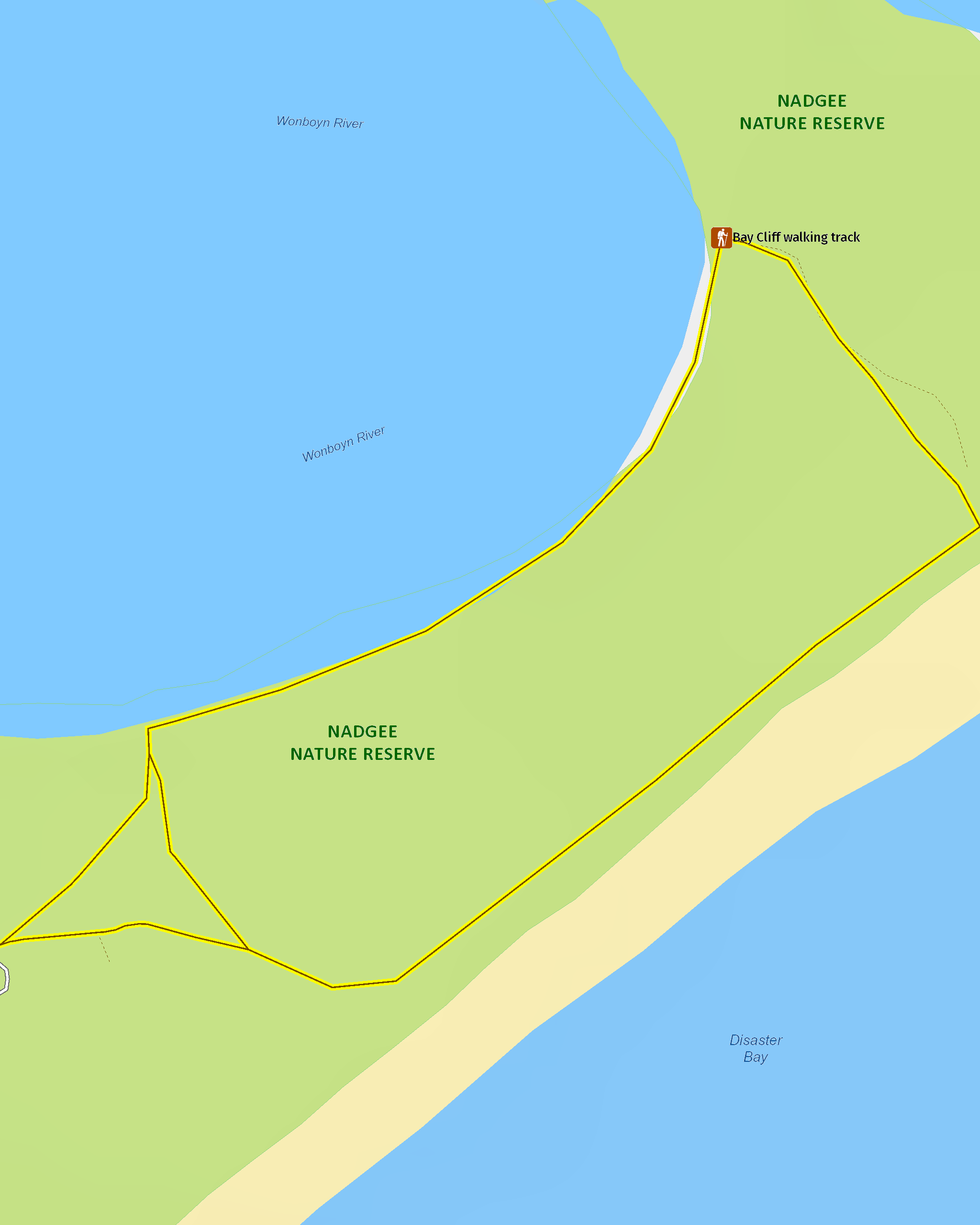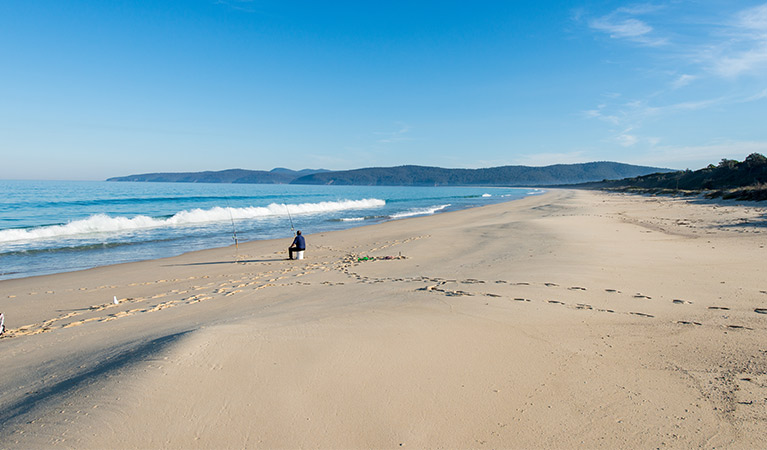Overview
Bay Cliff walking track offers families and bushwalkers an easy hike along the beach and the past the lake. Enjoy birdwatching and fishing along the way.
- Where
- Nadgee Nature Reserve in South Coast
- Accessibility
- Hard
- Distance
- 1.2km loop
- Time suggested
- 30min - 1hr 30min
- Grade
- Grade 3
- What to
bring - Hat, drinking water, sunscreen
- Please note
- Remember to take your binoculars if you want to bird watch and whale watch.
On the Bay Cliff walking track, you’ll follow the edge of Wonboyn Lake where you can see pelicans and waterbirds feeding, with shell middens around the shore. Then head through the forest to secluded Wonboyn Beach. The views across Disaster Bay and the magnificent outcrop of Bay Cliff only emphasise the reserve’s beauty.
There are also plenty of resting spots for little legs on this short walk. Indulge in some fishing in the lake or sea, it’s especially rewarding here.
Look for the yellow-tailed black cockatoos in the woodland; they love stripping the paperbark trees for the wood grubs underneath. At dusk, look out for elusive ringtail possums. These nocturnal creatures may just be waking up for the night.
Map

Map legend

Local alerts
For the latest updates on fires, closures and other alerts in this area, see https://www.nationalparks.nsw.gov.au/things-to-do/walking-tracks/bay-cliff-walking-track/local-alerts
General enquiries
- National Parks Contact Centre
- 7am to 7pm daily
- 1300 072 757 (13000 PARKS) for the cost of a local call within Australia excluding mobiles
- parks.info@environment.nsw.gov.au
Park info
- in Nadgee Nature Reserve in the South Coast region
Nadgee Nature Reserve is always open but may have to close at times due to poor weather or fire danger.
Visitor info
All the practical information you need to know about Bay Cliff walking track.
Track grading
Features of this track
Distance
1.2km loop
Time
30min - 1hr 30min
Quality of markings
Clearly sign posted
Experience required
No experience required
Gradient
Gentle hills
Quality of path
Formed track, some obstacles: The walk is 1.2m-wide and hard-packed ground near the carpark, becoming sandy as you progress along the loop. The section of the walk that crosses Wonboyn Beach is soft sand.
Steps
Occasional steps: In the northern part of the loop there are 2 sets of timber steps without handrails - one set has 7 steps and the other has 12 steps.
Getting there and parking
Get driving directions
Bay Cliff walking track is in the northern precinct of Nadgee Nature Reserve. To get there from Eden:
- Travel south along the Princes Highway for 22.5 km
- Turn left onto Wonboyn Road and follow the road to Myrtle Cove
- Follow Nadgee Road, which continues on from Myrtle Cove, to the entrance of Nadgee Nature Reserve.
- Continue along Greenglade Road – it commences at the signpost for Nadgee Nature Reserve.
- Turn left off Greenglade Road into Bay Cliff Road and right again at the signpost for Bay Cliff
Road quality
Check the weather before you set out as the road to Bay Cliff can become boggy when it rains.
Parking
Parking is available at the end of Bay Cliff Road in hard-packed ground carparks.
Best times to visit
There are lots of great things waiting for you in Nadgee Nature Reserve. Here are some of the highlights.
Autumn
Autumn is a great time to enjoy Nadgee, with the mild climate favouring walking and picnicking, flower spotting and birdwatching.
Spring
Try your luck spotting humpback whales as they migrate south to the Antarctic on any of the beaches and headlands within Nadgee Take one of the many walks – short or long – and view the beautiful wildflowers .
Summer
Relax by the pristine beaches and rivers within the reserve.
Weather, temperature and rainfall
Summer temperature
Average
17°C and 22°C
Highest recorded
37.2°C
Winter temperature
Average
10°C and 16°C
Lowest recorded
2°C
Rainfall
Wettest month
January
Driest month
August
The area’s highest recorded rainfall in one day
370.1mm
Facilities
Drinking water is not available in this area so it’s a good idea to bring your own.
Toilets
There's a toilet at Bay Cliff carpark where this walk begins.
Maps and downloads
Accessibility
Disability access level - hard
Assistance may be required along the following parts of Bay Cliff walking track:
- There are 2 sets of timber steps without handrails in the northern part of the loop, one set with 7 steps and one with 12 steps.
- Although the track starts off as hard-packed ground, it starts to become sandy as you progress along the loop
- The track crosses Wonboyn Beach, which is soft sand
- There are toilets at Bay Cliff carpark where this walk begins, but they're not accessible or ambulant.
Permitted
Fishing
A current NSW recreational fishing licence is required when fishing in all waters.
Prohibited
Pets
Pets and domestic animals (other than certified assistance animals) are not permitted. Find out which regional parks allow dog walking and see the pets in parks policy for more information.
Smoking
NSW national parks are no smoking areas.
Learn more
Bay Cliff walking track is in Nadgee Nature Reserve. Here are just some of the reasons why this park is special:
A spring treat

The vegetation in Nadgee has been almost undisturbed since European settlement. In the heath, you'll see the red and pink flowers of the common heath, masses of orange banksias, and the white blooms of the wedding bush. As summer approaches, breathe in the sweet aroma of the cream flowers of the giant honey myrtles that grow near Wonboyn Lake and the beach. With its combination of coastal heath, forest and shoreline, Nadgee is inhabited by many different species of birds. From catching glimpses of tiny wrens and ground parrots in the heathlands to staring awed at soaring white-bellied sea eagles along the coastline, you'll need your binoculars to make the most of bird watching opportunities.
- Greenglade picnic area From Greenglade picnic area you can explore one of the most magical and deserted beaches in Nadgee. Try your luck at fishing and spend the day relaxing at this convenient spot.
- Jewfish walk The easy Jewfish walk takes you through the forest to the edge of Wonboyn Lake, where you can enjoy swimming, birdwatching, fishing and picnicking.
- Merrica River nature trail Those seeking a bushwalk through pristine landscapes and along deserted beaches swimming, fishing and picnicking on the way – should head to Merrica Creek nature trail.
Living treasure

Whatever part of Nadgee you explore, you'll be rewarded with pristine landscapes and stunning vistas. The reserve sits within Australia's Coastal Wilderness, which runs from the south coast of NSW to East Gippsland in Victoria, one of the 16 areas named as Australia's National Landscapes because of their natural, cultural or spiritual significance. It really is a special place.
- Bay Cliff walking track Bay Cliff walking track offers families and bushwalkers an easy hike along the beach and the past the lake. Enjoy birdwatching and fishing along the way.
- Nadgee wilderness walk Nadgee wilderness walk is a challenging and spectacular 55km walk from Merrica River to Mallacoota for experienced hikers only. Enjoy coastal views, birdwatching, whale watching and camping in the wild.
People of the land

The area of the reserve is part of the lands of the Bidawal people and shared with the Dtharwa and Monaroo people. Aboriginal people have a long spiritual and cultural association with the area around Nadgee. Before settlement, they would travel from as far away as Wollongong, Mallacoota and Monaroo to places like Bay Cliff and Greenglade. Middens can be seen around Wonboyn Lake and along the shore.
Plants and animals protected in this park
Animals
-

Eastern ground parrot (Pezoporus wallicus wallicus)
The eastern ground parrot is a beautiful, ground-dwelling native bird that lives in low heathland habitat along the NSW North and South coasts and escarpments. It’s listed as a vulnerable species in NSW.

